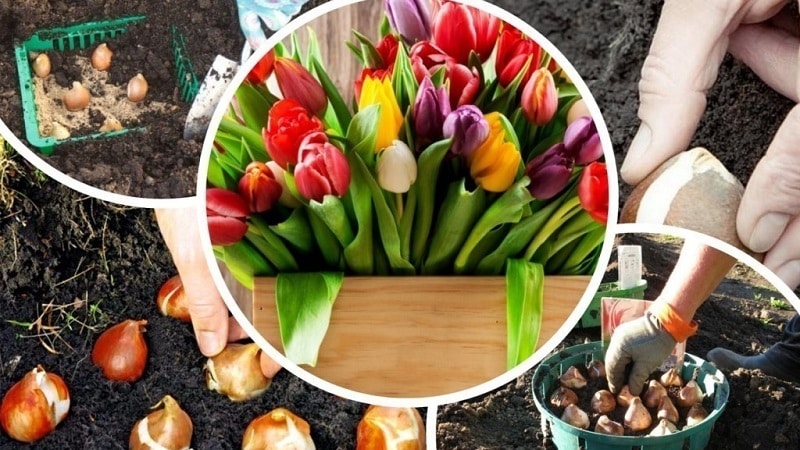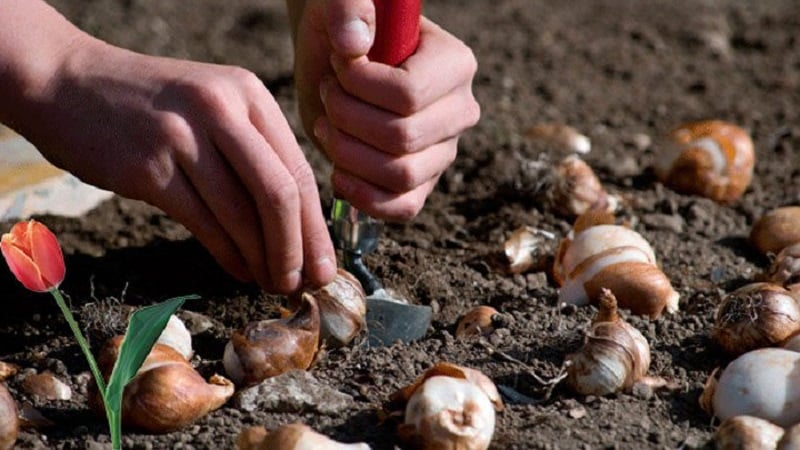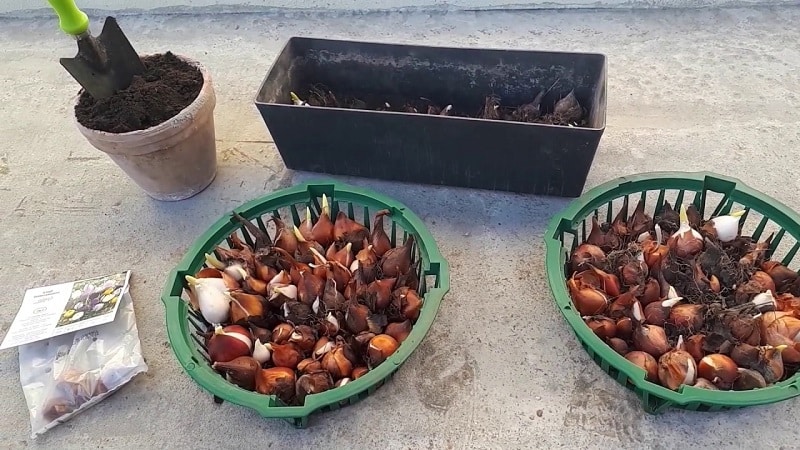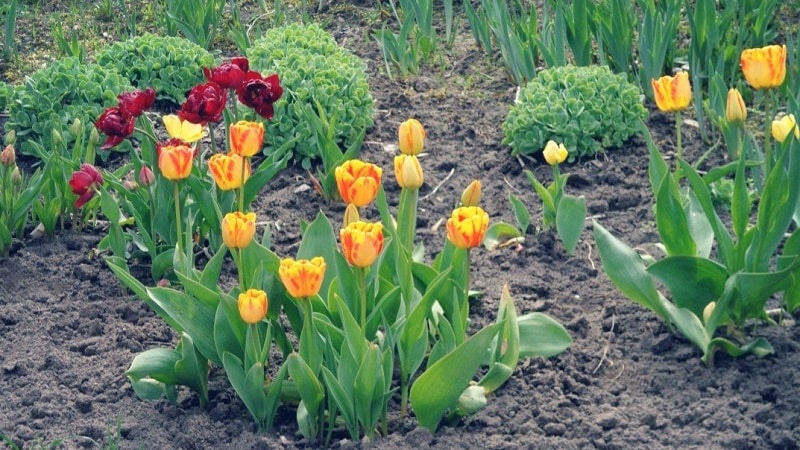We are planning to plant a garden: is it possible to plant tulips in the spring, and when will they bloom?
Tulips are a symbol of the coming spring. Yellow, white, red, pink - they decorate the garden plot and attract attention. Most gardeners plant flowers in the fall so that they have time to bloom the following year. Is it possible to plant tulips in spring? Yes, if you follow the rules of planting and care in the open ground. We will tell you when to start planting and what agrotechnical recommendations to follow.
Is it possible to plant tulips in spring?
Everyone decides for themselves when to plant tulips - in spring or autumn. However when planting in spring, it is important to remember that bright and elegant flowers will appear only next year. It takes more than one month for the flower bud of the bulb to mature.

The advantage of spring planting is that the rhizome is formed during the spring and summer, heat accelerates its development. At the same time, the process of formation and flowering of buds is delayed, and you have to wait another year before bright flower beds appear in the garden.
Attention! Planting time depends on the region. In the southern regions this is the end of February - the beginning of March, in the middle zone and the Moscow region - the beginning or middle of April. In the northern regions, planting begins in late April or early May. To prevent the sprouts from dying, the soil temperature at a depth of 10 cm must be at least +9°C.
Preparing the bulbs
Most often, gardeners prepare bulbs in the fall, collecting them from the flower bed. The bulbs are dried, cleared of soil and placed in wooden boxes.. A dry and ventilated cellar or basement is suitable for storage. Some gardeners store the bulbs in the refrigerator - low temperatures harden them and maintain their viability. But you can also purchase ready-made bulbs in specialized gardening stores, be sure to inspect them for damage, stains, and signs of rotting.
After the bulbs are placed in a weak solution of potassium permanganate for half an hour. It kills dangerous microorganisms and disinfects planting material, protects against diseases and insect pests. After the bulbs are dry, they are inspected. Bulbs with mold or damaged areas are thrown away. Such planting material will not produce grow healthy and beautiful flowers.
Attention! If you don’t have potassium permanganate on hand, a disinfectant solution is prepared from a decoction of pharmaceutical celandine. It has bactericidal properties and protects tulips from fungal infections.
Soil preparation
For tulips, loamy and sandy loamy cultivated soils with a neutral reaction are chosen. Flowers do not take root well on clayey, acidic soils. When planting, peat, sand or sawdust are added to the soil - the soil becomes lighter and more breathable.
If the soil is sandy, the bulbs dry out quickly; in this case, you need to pay attention to regular watering. Organic matter - peat or compost - helps improve the condition of such soil. It makes the soil more nutritious. Do not grow flowers on soils located near groundwater. If there is no other option, crushed stone or broken brick will help improve the drainage qualities of the soil.

As soon as the snow melts and the ground thaws, it is dug up to the depth of a spade bayonet. Fertilize the soil with organic or mineral fertilizers — add chicken manure, vermicompost, and complex fertilizers. It is not recommended to apply fresh manure - it will lead to rotting of the roots.
Attention! To plant tulips, choose a flat and well-lit area, protected from the wind on all sides. It is important that there are no uneven areas or depressions nearby where water will accumulate in the spring. Otherwise, a lack of sun will lead to curvature of the stems, and high humidity will lead to rot, brittleness and a decrease in flowering time.
How to plant tulips in spring - step-by-step instructions
After selecting and preparing the land, planting begins. It is better to do this on a cloudy and windless day, before lunch.
How to plant tulips:
- the ground is leveled with a rake, large lumps of earth are broken up, plant residues and last year’s leaves are removed;
- make furrows about 5 cm deep, place the onions in them with the tip up and sprinkle with earth, leaving a distance between the holes of at least 7 cm;
- Water the ground generously with warm water so that the bulbs are compacted into the soil.
Sometimes gardeners do not plant tulips immediately in open ground, but first in pots. After the flowers germinate, they are transferred to the site. This planting is similar to preparing seedlings. Gardeners prepare low and wide ceramic flower pots. They allow air to pass through, which is beneficial for the root system.

Instructions for planting in pots:
- Place pebbles at the bottom of the container, the thickness of the drainage layer is no more than 5 cm;
- fill the pot with soil (mix garden and store-bought soil) so that there is 10 cm left to the top;
- place the bulbs point-wise into the ground;
- cover with soil so that no more than 3 cm remains to the top;
- place the pots in a sunny place in the house or country house;
- pour plenty of warm water.
Interesting things on the site:
Care after landing
Tulips are demanding of moisture, but at the same time do not tolerate waterlogging. Water them up to three times during the growing season, while per 1 sq. m uses about 50 liters of water. Water must penetrate to a depth of 30-35 cm to reach the bulbs. Water at the root so that the liquid does not fall on the leaves and stem. The best time to water is morning or evening. Excess moisture causes cracks to appear on the bulbs. This entails the development of fungal and viral diseases. In the future, such an onion is poorly stored.
For healthy development, tulips require nitrogen, phosphorus, potassium, iron. Summer residents use ready-made complex fertilizers, for example, Kemira Universal or Magic Watering Can. They contain vitamins, macro- and microelements necessary for the plant. Ready-made fertilizers are convenient; they are diluted in water according to the instructions on the package. To improve the quality of the soil, add ammonium nitrate, nitrophoska, ammonium nitrate or ammonium sulfate.
Attention! For spring feeding, flower growers choose wood ash. It is applied during the period of active growth of tulips. Potassium sulfate is also used in spring - it does not contain chlorine and nourishes the plant. If the flower lacks magnesium (which is easy to understand by the lethargy of the stem), the soil is fertilized with potassium magnesium or dolomite flour.
It is important not to forget about weed removal and loosening. These procedures improve the quality of the soil and protect against insect pests. Loosen the soil at a distance of 10-15 cm from the stem so as not to touch the bulbs and rhizomes. Weeds are removed once a week.
Tips and tricks
Mulching will help protect flowers from insects and weeds.: summer residents sprinkle the ground with a mixture of sawdust, ash, hay, and mown grass. Mulch retains moisture in the ground, which has a beneficial effect on flowering.

If the flower is covered with spots and variegated stripes, it means that it has contracted a common disease of tulips - variegation.. It is impossible to cure it, so such flowers are removed from the area. There are many reasons for the appearance of the disease: contaminated soil, poor-quality planting material, non-compliance with planting deadlines.
If the tulip is covered with gray or white fluff, it means it has become infected with rot.. As a rule, this happens in wet weather. If it rains frequently, gardeners pay attention to the drainage layer. It is also recommended to plant calendula or mustard nearby. These plants secrete phytoncides - substances that inhibit the growth of pathogenic bacteria.
Read also:
Growing petunia at home and in open ground
Varieties and features of growing terry petunia
Varieties of ampelous petunias and features of their cultivation
Conclusion
Before planting tulips in the spring, it is recommended to choose the right place: flat or hilly areas located away from groundwater are suitable for flowers. Tulips take root in loamy and sandy soils, which gardeners fertilize in advance with compost or peat.
Bulbs for planting are prepared independently or purchased in stores. Before planting on the site, they are placed in the refrigerator to harden and increase immunity. An important rule is to disinfect the bulbs; they are soaked in a weak solution of potassium permanganate. It is important to remember that when planting tulips in the spring, you will only be able to get a beautiful flowerbed the next year.